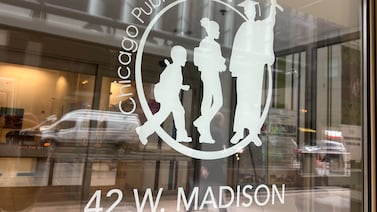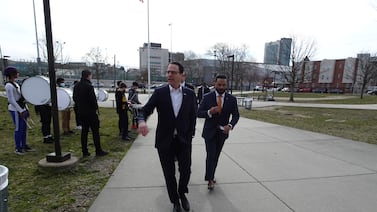Update: A final version of the guide for schools was released Monday. It placed the threshold for test positivity that would tip a district into the red, higher-risk category at above 7%.
As Colorado school leaders have struggled to decide when it’s safe to open schools, and what data to track, a group of local public health agencies have stepped in to offer new guidance.
The draft framework, developed by public health agencies in the Denver metro area, lays out three metrics of available data that school districts should look at, and offers a color-coded rubric using three traffic light colors, where red suggests a higher risk.
Over the course of the summer, about half the school districts in the metro area decided to start the school year remotely while the other half decided to open their school buildings. The framework could provide a consistent way to think about risk, but it would not be binding.
John Douglas, director of Tri-County Public Health, presented the draft to the Aurora school board at a public meeting this week. A final version of the guidance is set to be released soon.
“We want to provide the schools as much guidance as we can,” Douglas said. “We want to do so without telling you what you have to do because we think you’re an elected board of education, you’re the ones that should decide that, but we want to give you whatever guidance can be helpful to you.”
The draft’s three suggested metrics to consider are:
- The 14-day case rate per 100,000 people. Schools are in the green category if there have been fewer than 50 cases total per 100,000 people in the past 14 days
- The case rate trend. School districts would be in the green category if the cases have increased 25% or less in the last two weeks, compared with the previous two-week period.
- The test positivity rate. School districts would be in the green category if 5% or fewer of tests produce positive results.
The guidance also offers school districts three additional metrics they could use:
- Trends in hospitalization rates.
- Availability of personal protective equipment.
- Trends of cases in school-age children. Douglas said that typically the trends are the same for all age groups, but said that as schools open it might be helpful to watch for increases and decreases in trends that are unique to children.
The framework was designed as a suggestion, and school districts can choose how to use it, if at all.
“Some of the districts would like to use this guidance to pre-make decisions,” Douglas said, citing the example of the Cherry Creek School District where officials have created a point system. The district would earn points for each area that rates green, and earn zero points for a category rated red. In Cherry Creek, a certain number of points would trigger a different learning model. Whether a similar points allocation is suggested as part of the final framework is still up for discussion.
Other districts, Douglas said, don’t want “absolutes,” and may instead use changes in the community measures to trigger a serious discussion about the status of schools.
An analysis of several metro area counties shows that Adams County, by these suggested measures, presents the highest risk for school reopenings, by case rate and positivity rates. The trend measure, however, has Adams County cases going down.
The county is home to at least two school districts, Mapleton and Westminster, which are opening to students in-person. Both districts have high numbers of people of color and families living in poverty, groups that have been highly impacted by COVID-19.
Steve Saunders, a spokesman for Westminster Public Schools, which opened Thursday, said all guidance is useful, but that Westminster has already crafted its own way of deciding if it’s safe to open schools. It’s based on the state’s current Safer at Home phase.
“There is not one guiding document that we’re following, we’re creating our own,” Saunders said. “It is ultimately our decision and we’ve been in consultation with Tri-County Health.”
Adams 12, Adams 14, and the Aurora school district are all starting the school year online.
The Aurora school district boundaries are within both Adams and Arapahoe counties. Douglas said his agency is considering compiling data for school district based on their unique boundaries, but so far does not have such data.
The Cherry Creek district, which covers portions of Aurora and other southeast Denver suburbs, developed its own set of health metrics over the summer, in cooperation with Tri-County, that Douglas said he considered as he and others drafted the new framework.
These were presented publicly at the end of July. Superintendent Scott Siegfried said he was getting tremendous pressure from every direction on school reopening, and he wanted firm numbers to guide his decision.
And to help the community trust those metrics, he waited a week after presenting it before deciding whether to open.
“What I wanted the community to see was: I didn’t bake this in,” he said Thursday. “I didn’t know what the data was going to do that week. I presented it, and then watched with everyone else. And fortunately the data did get better. So we were able to start in person, as we had planned. But if the data had gotten worse, we would have started remote.
“Watching the real data, the science, the evolving nature of it, that was important.”







